Things to Come, Part Three:
Loudspeakers
In my last two "Things to Come"
pieces, I wrote about current trends in source
components and amplifiers. This third article
focuses on current loudspeaker technologies and trends, again supported by what I saw and
heard at the recent CEDIA Expo and the Rocky Mountain Audio Fest (RMAF), events that act
more or less as barometers for the industry.
Technologies
Most speakers sold today are conventional
multiway designs with dynamic drivers -- the cones and domes we've known for so long. The
oldest driver technology there is, the dynamic cone has been used for the better part of a
century to convert amplifier signals to sound waves. By multiway, I mean multiple
dynamic drivers, each responsible for a portion of the audioband. For example, in a
two-way design, a tweeter handles the higher frequencies, a mid-woofer the lower ones. In
a three-way speaker, a midrange driver handles the middle frequencies. In a multiway
speaker, the sound signal is split among the various drivers by an electronic device
called a crossover. But, like the dynamic cone itself, crossovers and multiway
speakers aren’t new. In fact, what you see in loudspeakers today are largely
refinements of old technologies -- little new ground is being broken.
That doesn’t mean there’s nothing to write about
-- occasionally, other speaker designs and technologies pop up. For instance, some smaller
companies make speakers in which a single drive-unit handles the entire audioband, with no
crossover at all. However, there are only a few such companies; in the grand scheme of
things, the high-end single-driver speaker is close to insignificant. Furthermore, every
single-driver speaker I’ve heard has had serious flaws -- despite claims made for
them of being "full-range," few, if any, actually are. There’s a reason
most companies make multiway designs, something that’s withstood the test of time.
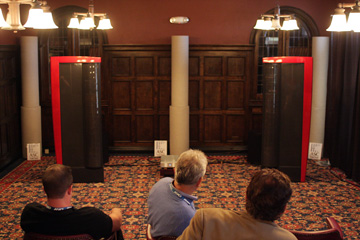
The MartinLogan CLX demonstration at CEDIA Expo.
|
You can also still find electrostatic
speakers: panel-type speakers that consist of a large diaphragm of very thin material,
usually Mylar. While their midrange and highs can sound remarkably good, electrostatic
panels don’t reproduce bass frequencies well; these days, most such speakers are
actually hybrids, with a dynamic woofer handling the bottom end. Electrostatics are also
usually quite large, require a lot of amplifier power, and can be finicky in terms of
placement in the room. As a result, they, too, appeal to a small crowd. Like the makers of
single-driver speakers, companies that produce electrostatic speakers are few. The
best-known is MartinLogan, who in 2008 debuted a new speaker, the CLX, that starts at
$20,000 USD per pair. The CLX is an example of that rarity, the "full-range"
electrostatic speaker -- it has no dynamic woofer. I heard the CLX a few times this year,
most recently at CEDIA Expo. It sounded quite good, although, not surprisingly, the
deepest bass frequencies seemed missing in action.
Overall, then, little about speaker technology has changed,
and it looks as if it won’t for some time to come -- after all these years, multiway
dynamic speakers still rule. Still, there are some new trends to report.
Trends
Three things now seem to be happening simultaneously with
loudspeakers. One has to do with making them more discreet and lifestyle-friendly; the
other two have to do with price.
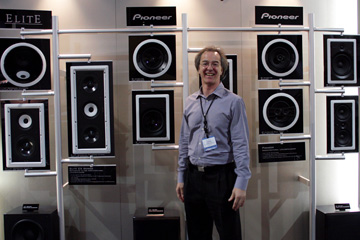
Pioneer's Andrew Jones at CEDIA Expo with the
company's new in-wall and in-ceiling speakers.
|
First, the lifestyle element: For years now,
with in- and on-wall speakers and the like, companies have been making speakers that are
more friendly to rooms and décor. In the past, however, the sound of such speakers has
been compromised by having to meet too many requirements of appearance, and they’ve
been considered second-rate by many in the audio press. That’s all changing.
Nowadays, companies like B&W, Definitive Technology, Paradigm, Pioneer/TAD, Polk
Audio, PSB, etc., are offering topflight in-wall, on-wall, and in-ceiling speakers that
feature innovative design features (they all have dynamic drivers) and high parts quality
that result in first-rate performance. Heck, now you can even get a high-quality in-wall subwoofer.
These speakers aren’t just convenient -- they’re convenient and good.
I’m astonished at how much in-wall, on-wall, and in-ceiling speakers have improved in
recent years -- many can truly be regarded as "high-end," which wasn’t how
it was not so long ago. This market, which is already huge, will no doubt continue to grow
rapidly as the quality of these types of speakers continues to increase.
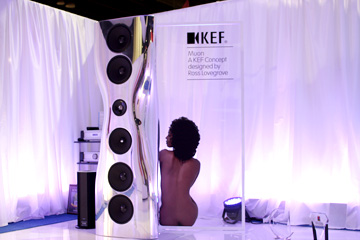
The KEF Muon display at CEDIA Expo.
|
Now, the first of two things about price:
Top-tier speakers keep getting more and more expensive, to the point that’s it’s
all getting ludicrous. The last I heard, KEF’s big, silver Muon speaker cost
$140,000/pair. Wilson Audio Specialties has just bumped the price of their Alexandria X-2
Series 2 from $148,000 to $158,000/pair. And at CEDIA, Focal of France showed off their
brand-new Grand Utopia EM for a mind-boggling $180,000/pair. With so many speakers priced
in the hundreds of thousands of bucks, no wonder some reviewers begin to think that models
going for $10,000 to $20,000 are "affordable." More than once at recent hi-fi
shows, I took a step back and asked myself: How many people actually buy this stuff?
With the economy in its present state, now is probably the
worst time in a long time to debut such products -- I suspect that very few pairs of these
super-expensive speakers are actually being sold. I also suspect that companies that have
focused on stratospherically priced speakers are already regretting having done so.
Regardless, the trend of rising speaker prices continues. I imagine that when the economy
turns around -- and don’t worry, it will . . . some day -- some companies will try to
push past $200,000/pair. If it doesn’t happen in 2009, watch for it in 2010.
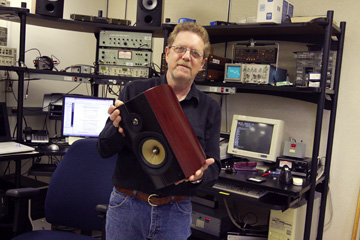
PSB's Paul Barton at Canada's NRC with the Imagine B.
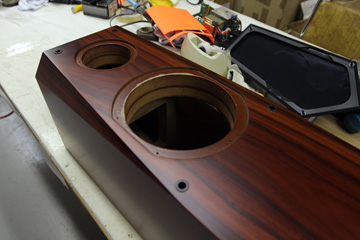
The Focus Audio FC7 cabinet during assembly.
|
But only the top-tier speakers are getting
more expensive, which brings me to my second point about price: The most affordable
products are getting better, and often cheaper as well -- which is good news for GoodSound!
readers. For example, at the CEDIA Expo, PSB introduced their new Imagine series, and last
month, Colin Smith reviewed the
Imagine B ($1000/pair). The Imagine B has high-quality parts and a top-quality cabinet
that’s curved on all sides -- even the bottom -- and is clad in expertly applied
real-wood veneer. It’s a real showstopper; in my estimation, if the Imagine B had
been offered only five years ago, it would have cost twice as much.
And it’s just one example of many. In early November,
I traveled to Focus Audio in Toronto, where I saw their new Classic line of speakers. The
new FC7 is a floorstander with high-quality drivers, a super-sturdy cabinet, flawless
real-wood veneer, and a price of $1630/pair. Five years ago, a pair of speakers with such
a high quality of finish would have cost $3000.
These aren’t the only companies producing topflight
speakers at low prices. Everywhere I looked at CEDIA Expo and RMAF, I saw many others
consistently offering better speakers at lower prices than they had only a few years ago.
It’s not really a miracle. Parts and manufacturing costs have gone way down even as
their levels of quality have risen. To remain competitive, companies are passing these
savings directly on to the consumer. As a result, the products are getting better and
cheaper.
The contradiction is obvious: If, at the lower end,
speakers are getting better and cheaper, why, at the higher end, do prices continue to
rise? Are the top-tier speakers getting so much better that, despite the
improvements in parts and manufacturing efficiency, manufacturers are still forced to
raise their prices? Or is something else going on?
In my opinion, it’s the latter. Perhaps those who buy
stratospherically priced loudspeakers aren’t so much concerned with the value
they’re getting as with the prestige they bring -- the bragging rights that come with
being able to buy something that costs so much.
Regardless, GoodSound! readers can rejoice at
what’s happening among loudspeakers that most of us can afford.
Coming soon: 2009
These last three articles have detailed what I see as being
the most important trends in source components, amplifiers, and now loudspeakers. In a few
instances, I’ve made predictions. With 2009 just around the corner and many brand-new
products on the horizon, I’ll be interested to see how accurate those predictions
turn out to be.
See you next year!
. . . Doug Schneider
E-mail comments to the editor@goodsound.com.
|